Cape St. Mary’s Ecological Reserve in Newfoundland has been high on my bucket list for a few years now. It is often referred to as the most accessible seabird colony in North America.
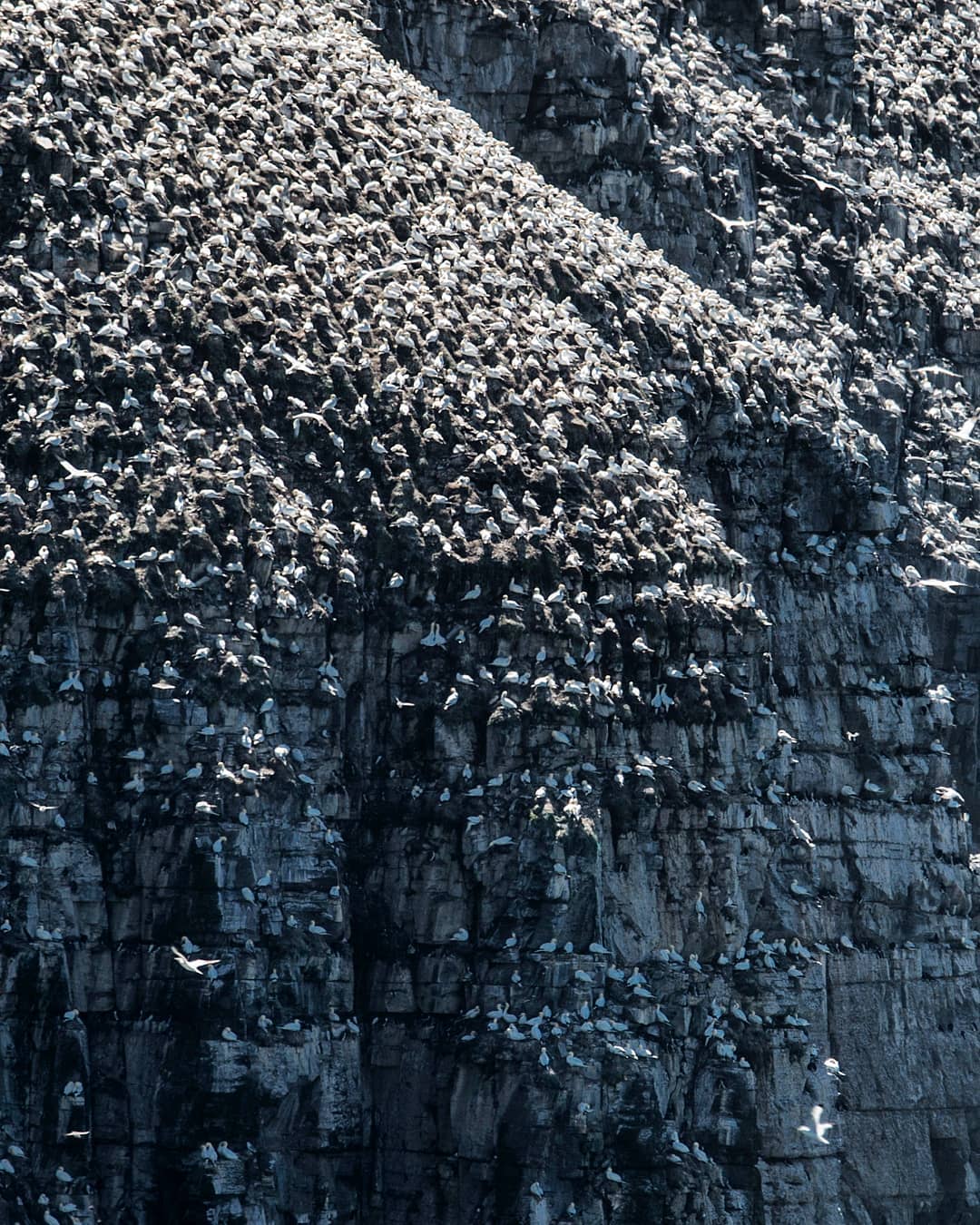
A short 1km walk through one of the world’s most southerly expanses of sub-Arctic tundra will take you to “bird rock”. Each summer these seaside cliffs become a nesting ground where tens of thousands of seabirds raise their young. 24,000 Northern gannets, 20,000 black-legged kittiwakes, 20,000 common murres, and 2,000 thick-billed murres. Along with more than 100 pairs of razorbills, and more than 60 pairs of black guillemots. There it just no way to distill what it felt like to be there into a photo. The scale alone is nothing I had seen before. Swipe to zoom in, see the cliff face, and get a sense for just how many birds nest here.

Northern Gannets are large seabirds, weighing up to 8 pounds, with wingspans of almost 6 feet! They are social birds, living in colonies of up to hundreds of thousands. They reach sexual maturity around 4 years of age. At which point the males will work on building a nest, and the young females will soar above the colony looking for a nest and partner that is to their liking. Once she has selected her mate, they will generally stay together for life. Gannet pairs perform a “bill fencing” ritual when one of the partners comes back from foraging for food and is ready to take over the role of incubating the egg (as you can see in this capture). It almost seems like its a sort of secret handshake that confirms the identity of the partner among the thousands of other birds in the colony.
It is often referred to as the most accessible seabird colony in North America.
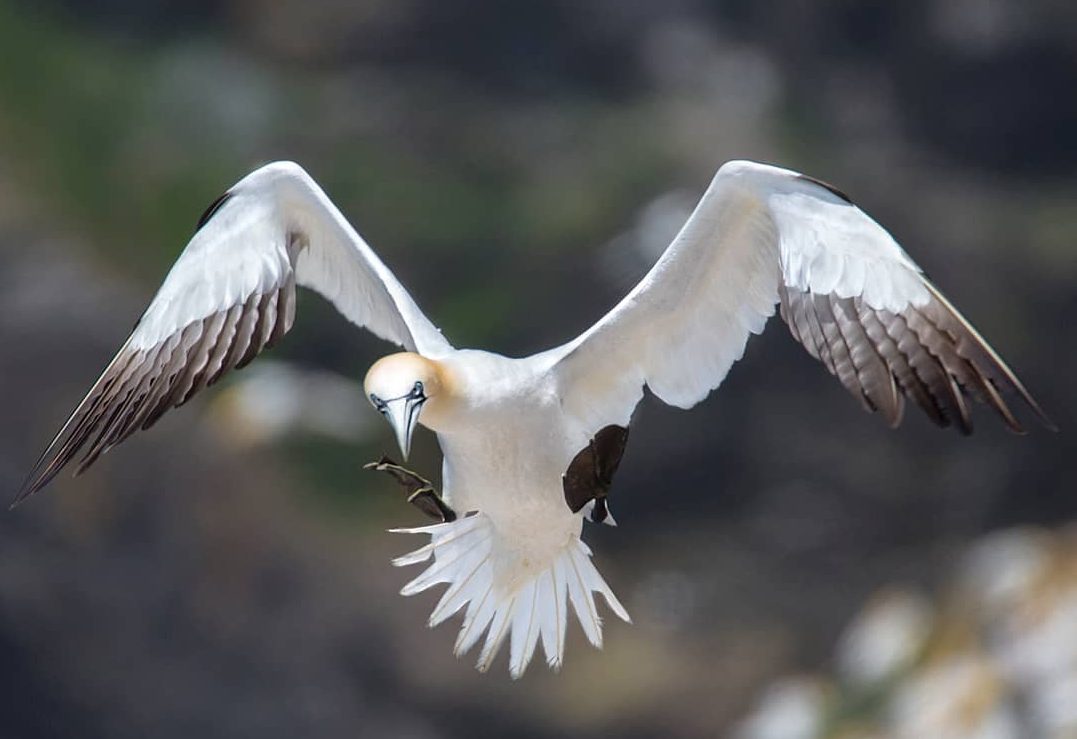
Northern Gannets angle their wings and fan out their tail feathers to create drag and control their speed when landing. Landing and taking off on land is actually quite difficult for gannets, which is partially why they nest on steep cliffs. Where gannets really shine is on water. Their wings are long and narrow and positioned towards the front of their bodies. This allows them to efficiently use air currents while flying. Gannets are incredibly efficient flyers, more efficient than any glider we have ever designed. They glide for hours, just above the wave-tips, rarely moving their wings, by taking advantage of the updrafts of air which are caused as the horizontal wind is reflected up as it hits the wave. The gannet will use these updrafts to gain height and then glide back down to the next wave. Even in calm weather they can reach speeds of between 55 and 65 km/h (34 and 40 mph).
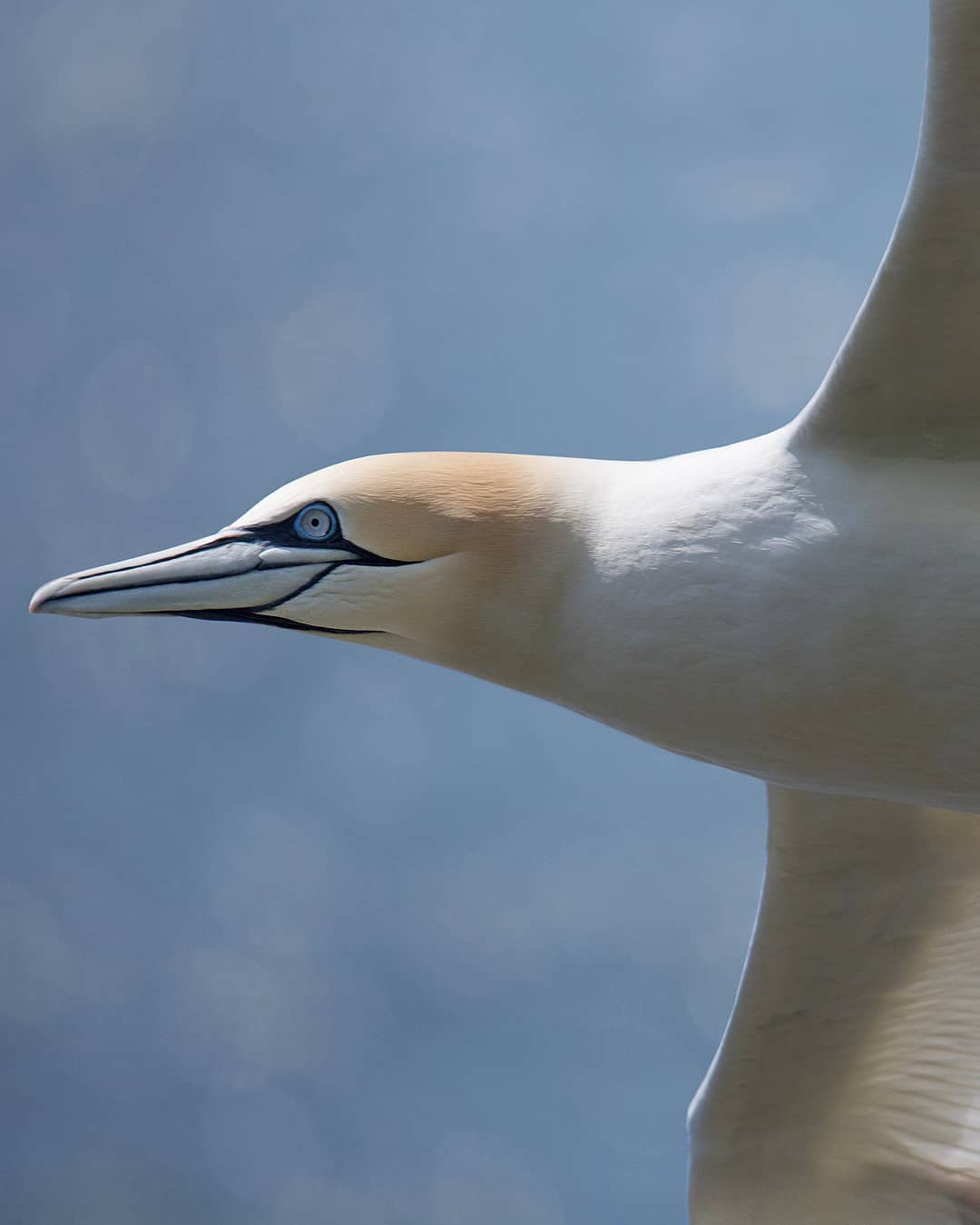
Northern Gannets like other seabirds spend most of their lives out at sea. They rarely approach land, with the exception of the few months in the summer when they breed and raise their young. Their seafaring lifestyle bring a number of unique challenges with it. One of these challenges is the need to remove salt from their bodies. Salt gathered from the ocean, and subsequently in the fish they eat. Gannets (and other seabirds) have specially designed salt glands located above their eyes. These glands filter out the salt that builds up in their blood stream. The salty solution then trickles out of their nostrils. Another challenge they face is how do they survive violent weather often occurring in the ocean, such as hurricanes? Caleb Spiegel, a wildlife biologist with the United States Fish & Wildlife Service, and his colleagues at the Bureau of Ocean Energy Management attached GPS transmitters to the tail feathers of a number of sea birds before hurricane Sandy approached in 2012. One of the gannets that were tagged headed directly into the storm, however when it got close, it made a sharp u-turn and backtracked a good ways. It then headed back out to sea in a different direction. It waited for the storm to pass, all the while foraging for fish. Once the storm has passed it proceeded along it’s initial path. In my research I learned that this is very common with many other types of birds. Some birds have even been known to go into a feeding frenzy before a hurricane approaches, then will use those food reserves to sustain them while they leave the area and wait for the storm to pass. So amazing! PS. I probably spend 30 minutes trying to get this shot. My camera could just not auto-focus fast enough during close proximity flybys. I ended up locking my focus quite close to the range I was looking to photograph them. So when the gannet would fly by I would track it through my viewfinder then once in focus I would take the shot.
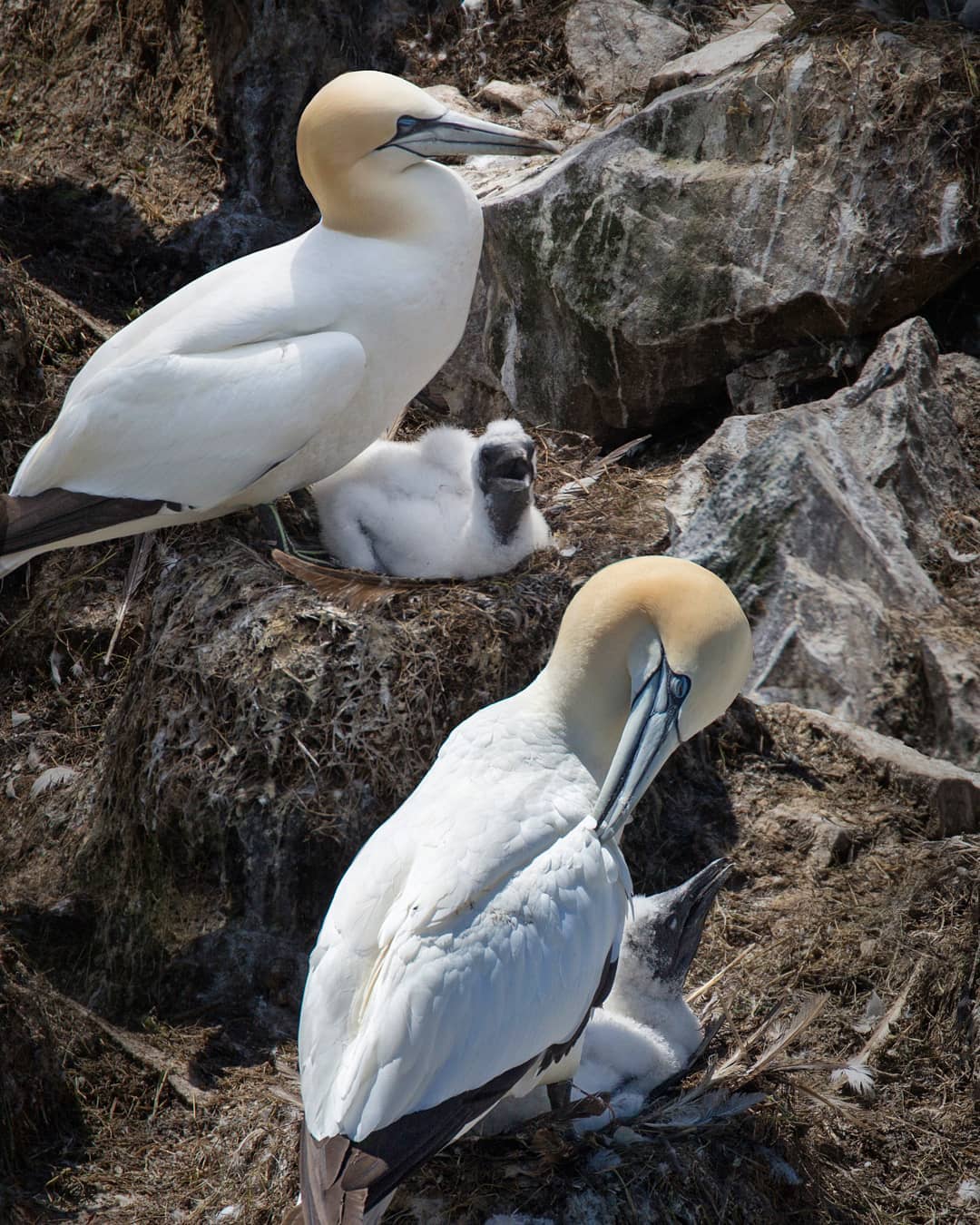
We were fortunate to visit this Northern Gannet colony after the chicks had hatched, so we could see first-hand how well their feathered parents take care of them. A gannet pair will typically use the same nesting site year after year. In fact the same nest may be used by multiple generations, with the nest being added to each subsequent year with new building material. The female lays a single light blue coloured egg between late May to mid June. The male and female both take turns incubating the egg. The egg will hatch around the first week of July. When first hatched, the chick is grey, naked, and helpless. After about 2 weeks they will be covered in a protective layer of white down (which is the stage we got to see these chick in). Plumage will grow at the six week mark and flight feathers will be fully grown by September. It is then that the chicks take the plunge into the ocean, half gliding, half falling. Once on the water they will stay there for a number of days, living on their body fat, as their wings are not yet fully developed for flight. Pretty soon their instincts will kick in and they will begin to learn how to swim underwater to catch their food, and to fly.
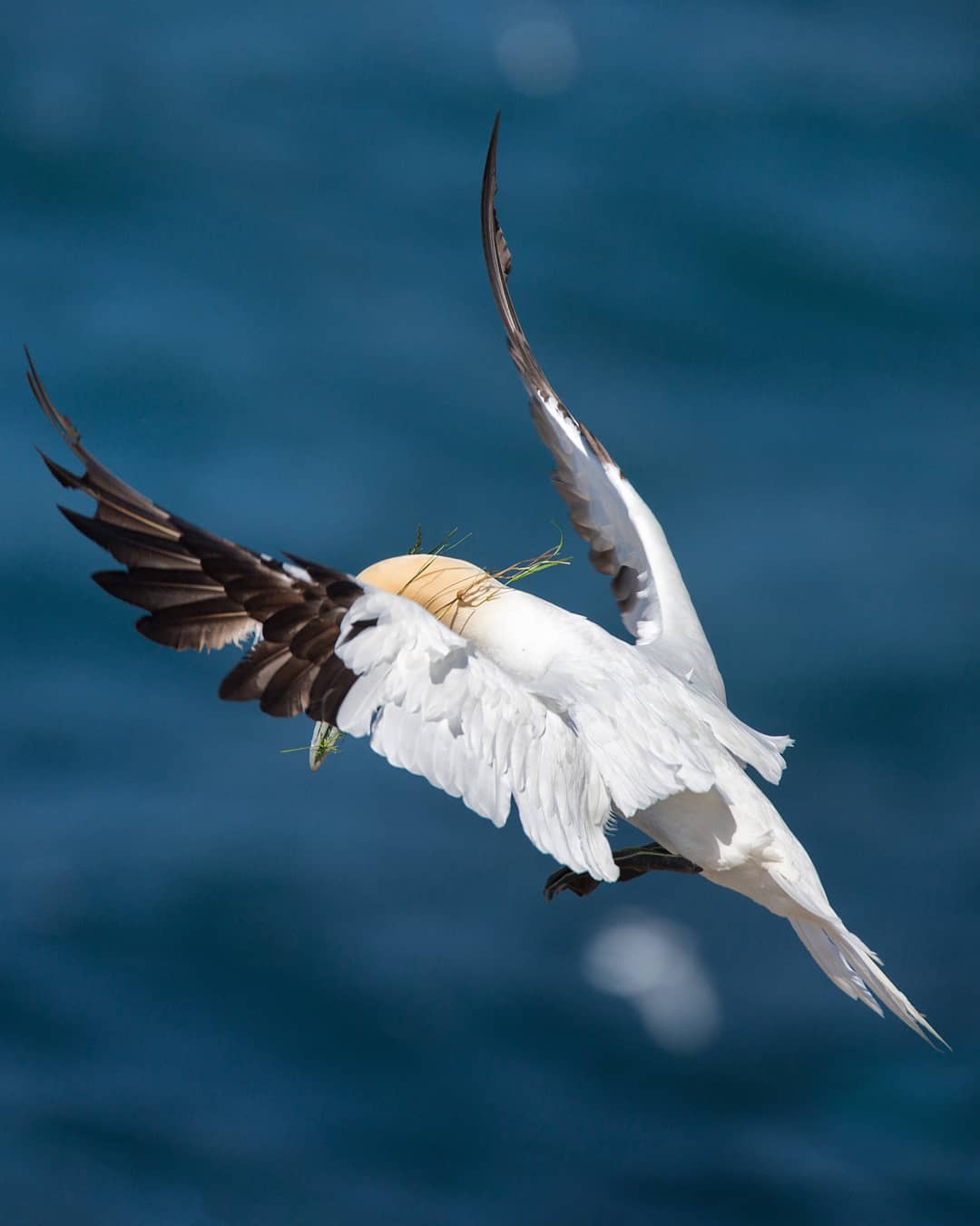
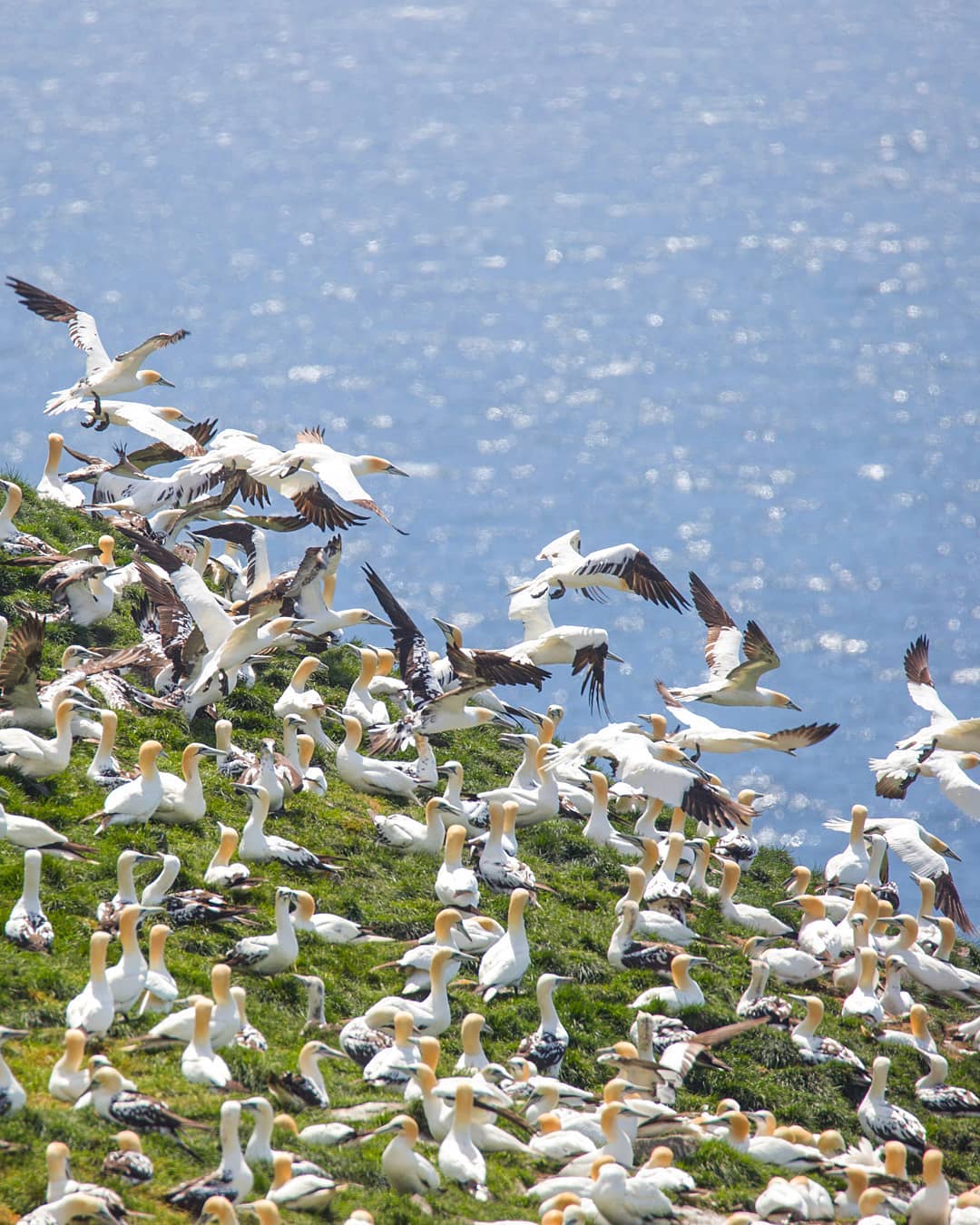
During our 4 or 5 hours with this colony I noticed a flock of gannet gathered at the fringes of the colony. Most of these gannets had patches of darker feathers where most of the other birds on the main cliff rocks were pure white. We asked one of the on-site scientists why this was. She told us that these birds were still young, likely hatched a year or 2 ago, and have not reached sexual maturity yet. She said these birds return back with the group to the nesting site and tend to stick together at the outer edges of the colony. She also shared with us that while the older members of the colony are busy tending to their offspring, these youngsters use this time to learn the valuable skills of nest building, how to fly, and how to hunt for food. We noticed a few times a large group of these younger birds would take flight at the same time, fly around for a bit and then land back down at the fringes of the colony. It was really interesting to see how much social structure these birds have. When you first see them, all you see is a bunch of white-ish birds grouped together, but when you spend a few hours you can really start to see the subtle ways each member of the colony fits in and contributes to the health of the whole.
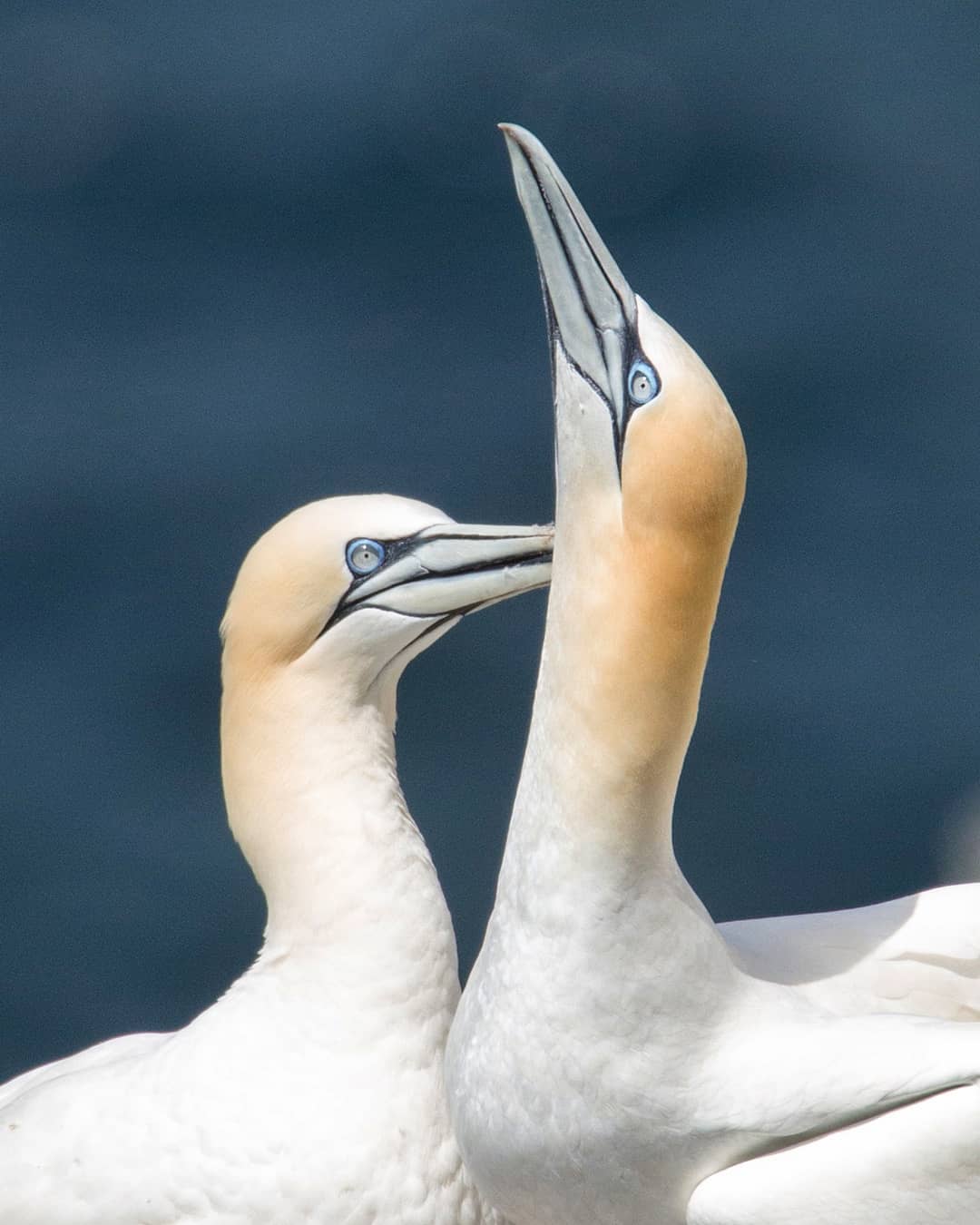
During the winter months Northern Gannets will travel as far south as the Gulf of Mexico, but each summer they will travel back thousands of kilometres to reunite with their life-long mate! It’s no wonder there is so much tenderness and affection shown between couples in the colony. This is especially impressive for Gannets, as they have a reputation for being aggressive towards each other. Gannets also only have 3 basic calls, so their body language and posture are very important in how they communicate. For example when one of the mates is ready to leave the nest in search for food, they will point their bill up in the air (“sky point”) before they take flight, letting their mate know they are about to leave the nest.
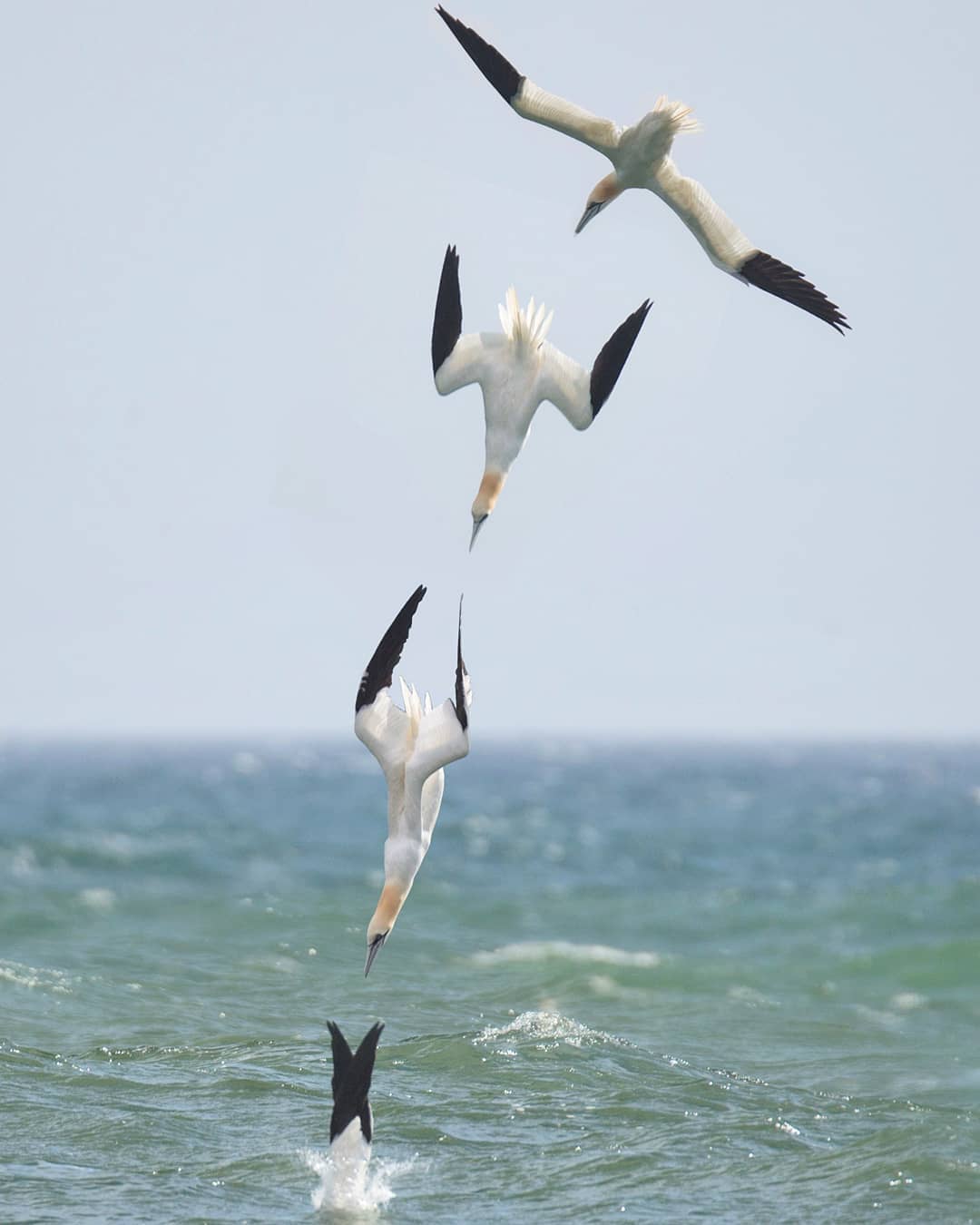
I’ve been waiting for this post all week. One of the most amazing aspects of Northern Gannets is their fishing technique. After @elizabeth__bruno and I left Cape St. Marys Ecological Reserve, we stopped at a beach with huge waves to take some photos. As we approached, we saw a group of about 6 photographers. It didn’t take us long to figure out why they were there. 50 or so Northern Gannets were diving into the waves to catch fish. I picked one of the gannets to follow through my viewfinder, and at a certain point it stopped flapping it’s wings in normal flight, locked eyes with something in the water, rotated it’s body to begin a vertical dive, tucked in it’s wings, and plunged through the waves. I created this composite using some of the photos from that sequence. Gannets dive from heights up to 230 ft, and can hit the water at speeds at up to 100km/h! Breaking the water surface at such speeds sends them down to a max of 36ft below the water surface. They are an absolute marvel to look at with their arrow like shape. Tomorrow I’ll talk about the amazing physical attributes gannets have that allow them to perform these spectacular maneuvers.
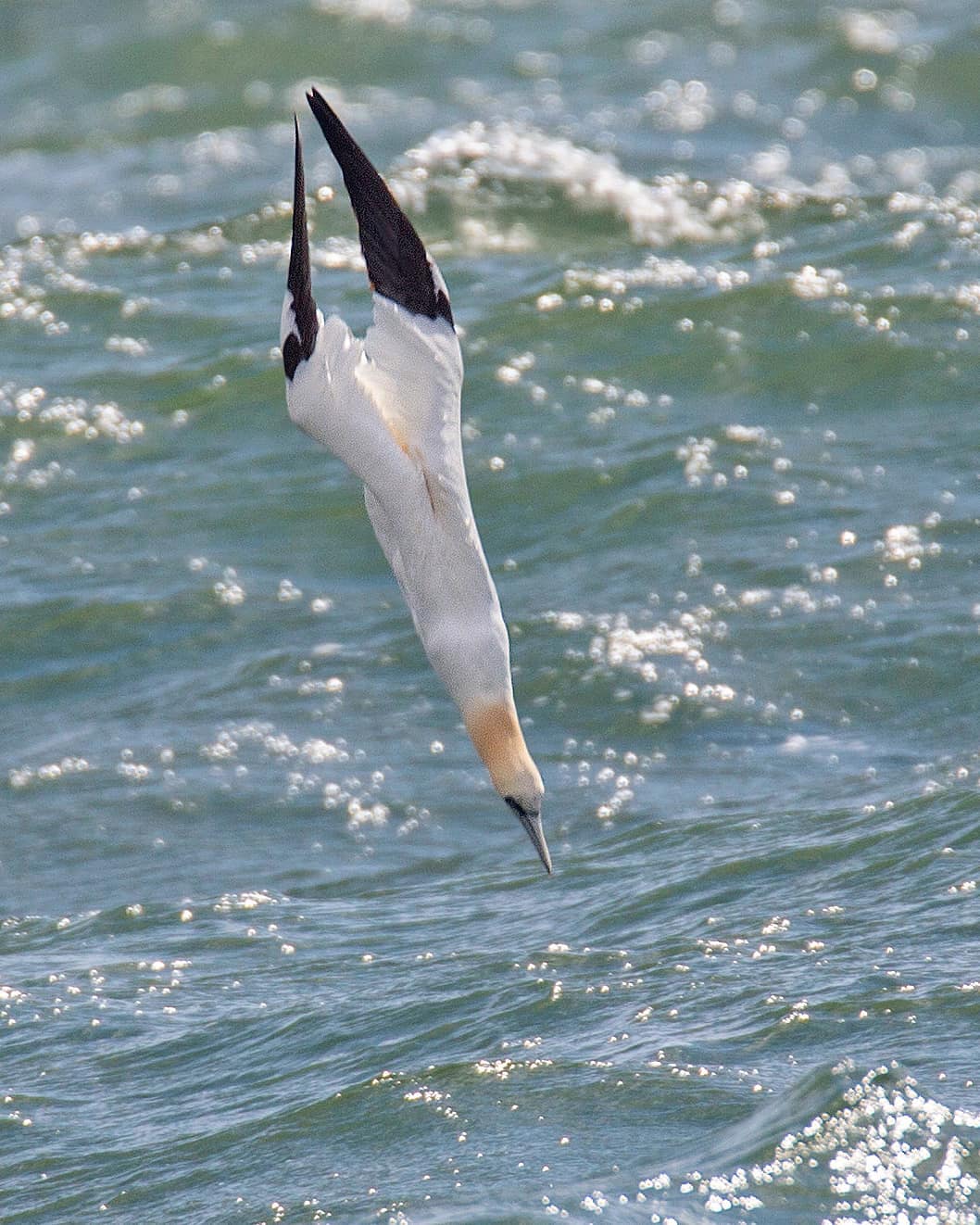
There are 3 engineering challenges that a bird like a Gannet needs to overcome when performing their death defying dives without hurting themselves. The first is sight. Most birds have eyes on the sides of their heads, this gives the advantage of having great awareness of your surrounding, but you lose the ability to judge depth. Gannet eyes are positioned far enough forward to allow them to see in front, and judge distances, which is crucial for their dives. The second is the impact. Hitting the water at up to 100km/h puts great stress on their bodies. Even though just before gannets hit the water they pull back and tuck in their wings beyond their tail, allowing them to pierce the water surface like an arrow, there is still a lot of force applied to their bodies. Amazingly gannets have tiny air pockets under their skin which they can inflate and deflate as needed! Imagine bubble wrap that acts like an airbag on impact. There are also some scientists who believe these air sacs may be used to help control buoyancy, in the same way a scuba divers suit does. Finally, their nostrils are located internally inside the mouth. This protects the nostrils from the immense force of impacting the water surface. On a side note: Once a gannet has secured its prey, it will usually swallow it before coming back up to the surface, reducing the chances of another bird stealing its food. In fact gannets have a sack branching out from inside their throat where they can store recently caught fish whole without causing any drag as they fly away. These birds are just incredible!
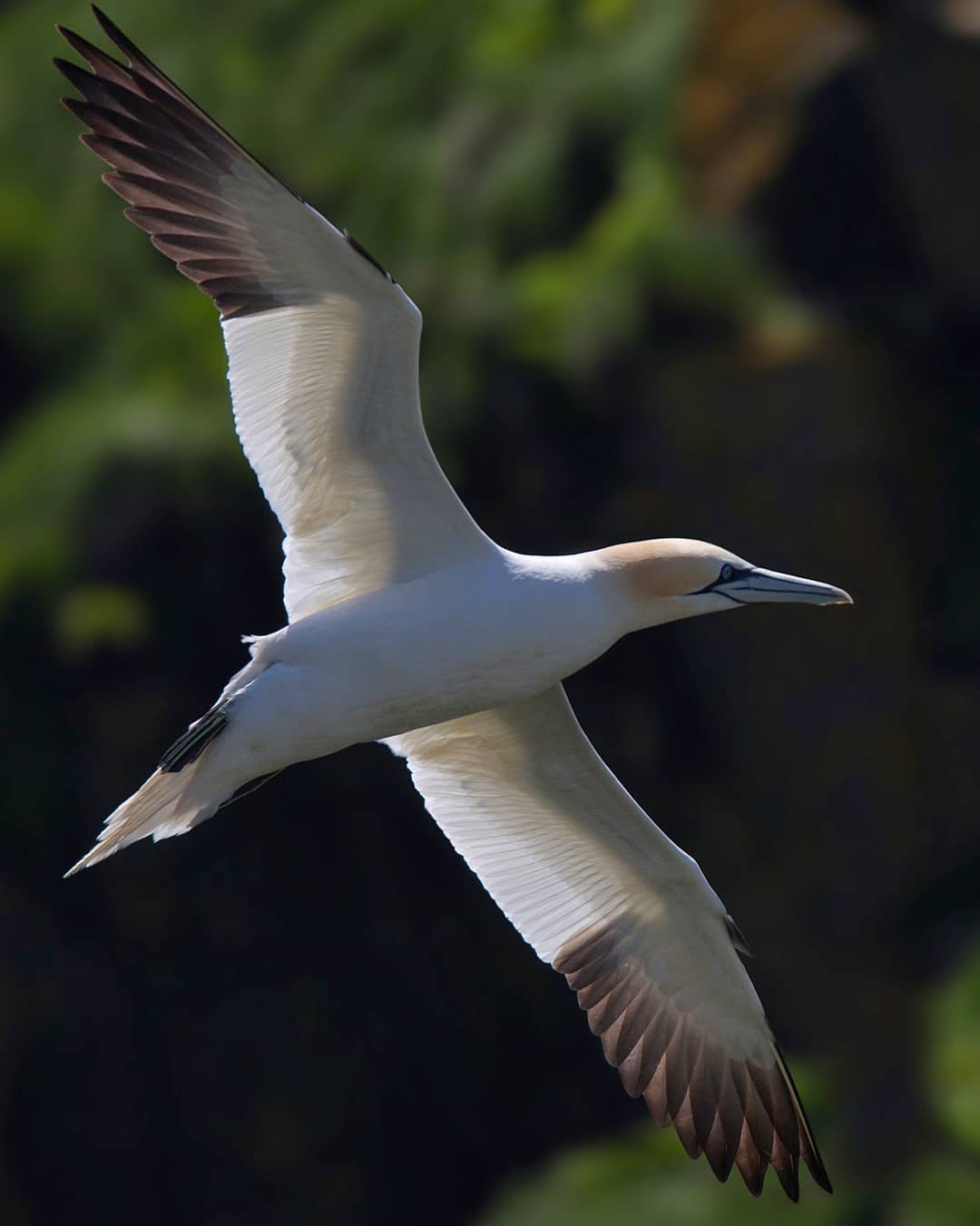
I have quite a few more Northern Gannet shots from the trip, but I think I’ll end the series here for now. I really hope you enjoyed learning about Northern Gannets. I definitely learned a lot about them from this trip and have a greater appreciation for the lives of seabirds. This last shot was another of those shots that took a while to get just right. Some of the gannets, while flying back to their nest sites, would swoop in around this cove area. It was a really beautiful sight. The moss covered dark cliffs in the shadows contrasted against the gannets blazingly white feathers. It took me a while to get the exposure just right and capture a frame of their flight that I was happy with.
What an honour it was getting to see these magnificent birds up close in such a spectacular way!



